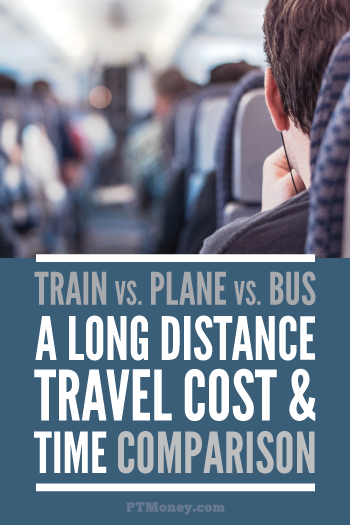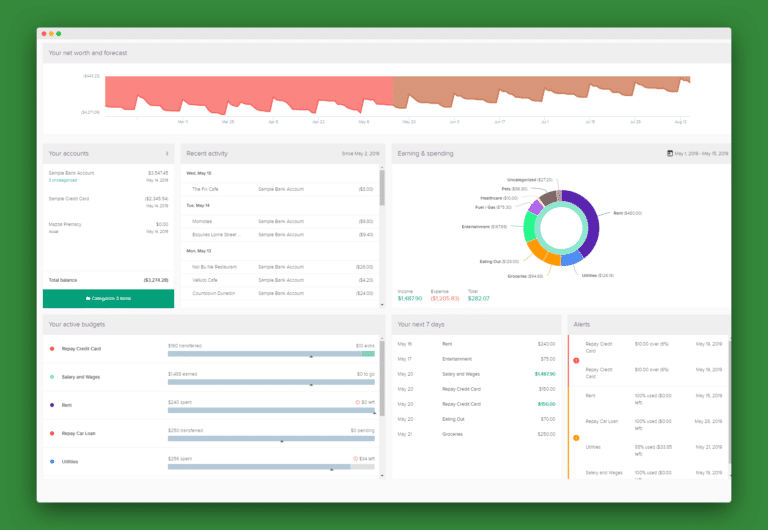Train vs Plane vs Bus – A Long-Distance Travel Cost and Time Comparison
One of my good friends is a train enthusiast.
When I was lamenting the cost of airfare for my recent trip to New York City for the BlogHer conference, my friend said (as he has said so many times before), “You should have taken the train!”
Ten years ago, I probably would have ignored his suggestion. But ten years ago, making regular flights from one part of the country to another was still a fairly cheap proposition, not even including the modern add-ons like checked baggage fees, booking fees, and seat selection fees to further increase the price of flying. Flying will probably always be the fastest way to travel, but it is starting to become expensive enough to warrant looking into other, slower, modes of travel.
To determine what kind of travel is going to be the best choice for price, time, and safety, I decided to look at a trip between Indianapolis (my home airport) and Denver, where #FinCon12 was held. I planned the hypothetical trip for the first week in December, giving me nine weeks’ lead-time (and avoiding the Thanksgiving travel glut). Here is what I discovered:

Air Travel Costs and Time
According to both Kayak.com and Southwest.com (my preferred airline), a single adult could fly from Indianapolis to Denver and back for the week of Monday, December 3 through Monday, December 10 for $230. This is a pretty good deal.
If you were to fly Southwest, the $230 would cover your flight and your first two checked bags. All you would need to shell out for is adult beverages on board, if you were so inclined. If, however, you were to take Frontier or United, which were the first two airlines offered on Kayak, you would have to pay for your checked luggage: $20 each for the first two bags on Frontier, bringing your total to $310 round trip, and $25 for the first bag and $35 for the second on United, making your trip a painful $350 total.
The good news is that all three of these airlines offer plenty of non-stop flights at this price point for this trip, meaning your total time in the air is about three hours. However, that does not include the time you need to allow for check in and airport security—an additional 90 minutes. Assuming you get a ride to the airport and do not have to park, then your travel time for this trip will be 4 ½ hours total.
As for safety, the good news keeps coming. Despite the nerves we all may feel in flying, it remains one of the safest means of travel. When comparing deaths per billion kilometers, there are 0.05 deaths through air travel compared to 3.1 in automobiles.
Rail Travel (Amtrak) Costs and Time
A single adult riding Amtrak from Indianapolis to Denver can travel in old school style for anywhere between $294 and $402. On the surface, it would appear that flying is the better deal.
However, Amtrak offers a 10% discount for AAA members, making the price a more competitive $264.60 to $361.80. Add in the fact that your first two checked bags ride free, and it makes the price even more reasonable. While meals and beverages are not complimentary on trains, you are permitted to bring your own food and drink on board and further save money that way. There are also really good dining options on board if you choose to splurge.
The timing of a rail journey is the real stumbling block. The cheapest fare available (which also happened to be the shortest time in transit) will take from Monday morning at 6:00 am until Tuesday morning at 7:15 am—a total of 25 hours and 15 minutes. The return trip is even longer at 28 hours and 40 minutes. This is even harder to swallow when you remember that the inexpensive fare is only paying for a reserved coach seat, which, while it may be more comfortable than the average airline seat, is still not the place you’d really like to be sleeping.
Safety-wise, train travel is a safe way to go, with only 0.6 deaths per billion kilometers. It’s statistically an extremely small risk, although it is still slightly higher than air travel.
Bus Travel Costs and Time
Riding Greyhound from Indianapolis to Denver will only set you back $198 round trip, making it the cheapest option by far. In addition, the first checked bag is free, and the second only costs $10, bringing your travel total to $208 — which is still cheaper than the next cheapest option of Southwest at $230. As for dining options, you will have to bring your own food or buy food at one of the bus stops or transfers.
Like rail travel, buses take quite some time. The outbound trip is 22 hours and 15 minutes, and the return trip is thirty minutes longer. I should also note that in order to avoid any transfers (where passengers are responsible for transferring their checked luggage to the new bus), I had to choose between a fare that leaves Indianapolis at 3:15 am and one that leaves at 12:30 pm. Add to that the fact that bus travel is not known for its comfort, and even the most budget conscious of travelers might rethink the idea of taking the bus.
I was surprised to find that bus travel is very safe, at only 0.4 deaths per billion kilometers. It also does well in other statistical measurements: it tops the safety list in deaths per billion journeys (4.3) and deaths per billion hours (11.1), both of which are metrics where air and rail don’t do as well because they carry more passengers.
The Bottom Line
It is unlikely that I’m going to start choosing Amtrak or Greyhound over air travel when planning any of my usual travel, much to my friend’s dismay. However, considering the lowered cost and the ability to take in scenery and enjoy the travel experience more, taking the train or the bus can be a fun part of the travel experience if you’re not in a hurry to get to your destination.
Have you ever taken the bus or train on a long-distance trip?





![How to [Finally] Stick to a Budget](jpg/how-to-finally-stick-to-a-budget.jpg)
The main problem we have here is that you can only pick one of the three modes for the whole journey, rather than combine the modes of travel to get the most efficient trip. In a more rational transportation system you’d be able to take a train or bus to a major airport, then a flight for the long haul, and at the other end the train and or bus if needed. This sort of thing is more common in countries with more advanced transportation systems than ours. In Europe, for example trains stations built into airports are not unusual. This is true of Amsterdam, Paris (Chalres de Gaulle airport), Frankfurt, Germany, and Stockholm, Sweden.
I’d love to take more train trips. While the time it takes might be considered a drawback, I think the journey/scenery is part of the fun! I’d take a novel for the tedious moments, and use the long travel time as a way to unwind before (and after) the actual vacation at the destination. Sometimes, going straight from work to vacation and right back to work makes the vacation not relaxing at all!
I take about one interstate train trip a year. The last several have been from the West Coast to Denver and Kansas City. Others to Omaha, and a mega-trip around the country.
When the (freight) RR’s do their job, the trips are on time and comfortable. Food service varies both by menu and price. I’d say the food is comparable to Denny’s or Marie Callendar’s.
Scenery beats flying, and there’s no hassle with onerous security procedures.
Doen’t cost me much, as I use my Amtrak Rewards Card to amass credits on travel.
. @KAYAK @ptmoney Except for this; why in the world are you checking two bags? Is this a three week trip?
@smcbride11 @kayak Emily, staff writer, has a toddler. Stroller maybe?
@ptmoney, @kayak Kids items get checked free on every airline ;-). But kids do explain it- mine end up using half my bag and 1 of their own.
I’ve never taken a train long distance. I took it from Seattle to Portland and it took six hours. The accommodations were comfortable — lots of room, ability to get up and walk around as needed — but the length of travel just wore me out. And as for Greyhound, saving $22 isn’t worth being stuck in a bus for a day. I know there are rest stops, but that also means I’m jarred awake if I’m trying to rest. That said, I have chronic fatigue, so your experience might be very different.
My MIL has mobility issues: severe arthritis in her hip and replaced knees. So she loved the train’s roominess. That said, it took 2-3 days to get from Seattle to Phoenix. She decided to get a little room, making the trip at least about the same (if not more) than a plane ticket. She enjoyed the ride, though, so I guess it works out.
@AbigailP Hi, I think it must be a very long time since you took the train from Seattle to Portland. The Talgo trains running on this line take only 3 1/2 hours according to the current timetable for this trip. When further ongoing improvements to the track are completed it will be even less.
Yep, sorry I thought I mentioned it was back in the mid-90s. It has gotten much better. That said, for longer trips you’re generally looking at 16+ hours. I just can’t handle those kinds of travel times.
@OECU would love to try the train route at some point, for positive reasons mentioned.
I’ve taken the train along with my then husband and young son from Denver to NYC. We’d reserved a sleeper because of our son for going one way. We were put into a sleeper directly over the axle of the car. It was extremely noisy through the night; I also had to share my bunk with my son (he was 3yo); he was a regular “wiggler.” So, needless to say, I didn’t sleep at all.
For the return trip, we had to go with coach seats; again, no sleep, altho the seats were comfortable for upright travel. This was back in 1987; I have no idea what that set us back. I will travel by train again for long distant trips, but I will make sure never to bunk on top of axles!
I have traveled by bus from LA to San Diego when I was in the AF. Way too many stops; it took forever to make the trip (which is 90 minutes by car).
I have a trip to San Diego (to visit my mom) coming up in the spring. Since I reside in PA, you can bet I will be flying to my destination, even if it means many layovers. I’ll save up all my pennies until I am about three months out and look at making plane reservations. With any luck, Phil, I will get lucky and find decent rates such as what you did.
Wish me luck. BTW, EXCELLENT post. Keep up the great work. I’m a fan forever….Jo
Its worth looking in to trains and buses for some routes like New York City to Ithaca, a flight can cost you a lot more especially if you factor in the student discounts Greyhound offers but airlines dont
Trains tend to offer student and disability discounts as well. And shorter trips can be great savings. My mom loves taking the Megabus from Philadelphia to NYC when she visits relatives. It’s under $20!
My mother-in-law took the Amtrak back from Denver to Iowa and it took her over 24 hours. Amtrak uses the same tracks as freight trains but the freight trains own the tracks so they have the right of way. She said there were times that they just sat there for over an hour.
@OneSmartDollar That’s my big hesitation with train travel – the thought of being trapped there. The adventure is appealing, but I think I’d rather have my adventure behind the wheel.